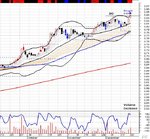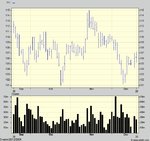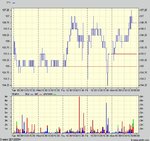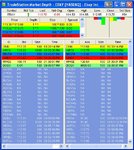china white said:
It is not arbitrary - and i think this is actually one of the major advantages of ADVFN charting. Again, pls do not ask me how thry get that data - I am not associated with ADVFN in any way -but their split of volume makes perfect sense to me.
Makes perfect sense to me. I am still testing ADVFN to see if what I think is correct but so far I have ni doubts that this is exactly what it is.
If you look at a Time & Sales cart you can see the sales and purchases in colour as they happen. Red for sales, Green for purchases. (Screen shot below)
I believe this is how it works (but I could be wrong)...
My explanation is based on a Nasdaq level 2 chart, as this is how I understand it and can explain it. A screen shot of my L2 screen is below, there is not so much activity as the market was closed when I took the shot.
Some people who want to buy a stock at a price will put their 'bid' into the market at the price they are willing to pay, if you are an ordinary person, then your bid will go in via an ECN and sit on the level 2 screen (left side of the L2 screen).
If you hold shares and wish to sell them at a particular price, then you can submit your 'ask' or 'offer' of sale on the right hand side of the level 2 screen.
The prices on the L2 are ordered by the cheapest at the top.
The very top prices are what you see on many software packages as the current bid and ask - also known as the 'yellow strip' price.
Most individuals though, buy at the 'market' price, ie. they by from the people who are selling on the level 2 screen. These purchases show up as Green on the Time and sales, they are people actively trying to purchase a stock now - this is purchase volume.
Someone trying to sell stock at 'market' price, sells to someone on the bid side of the L2 screen - this registers as selling volume (Red).
I believe that the colour coded volume you see on CW's chart is based on these figures, look at the Time and sales screen shot, you see mostly people actively purchasing at this point (Green prints) and you can see how many shares were transacted each time.
There are reasons why the trades 'at market' are counted as pressure (Buy or Sell volume), such as...
If no-one wanted to sell, those on the bid side of the screen just wouldn't be doing any business, they need someone to actively wish to sell to them for a transaction to be made and Vice versa.
Corrections or clarification on this are welcome.





